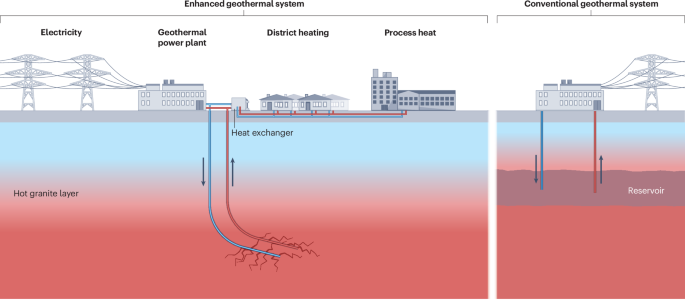I’m a huge nuclear energy advocate, but if there is an even better way to get baseline power to fill in the gaps between solar and wind I am all for it. My only question would be the downsides (if any) of using the earths core to power things.
Like if every country starts slapping these things down all over the place would it even start cooling the core in any meaningful way? Would that potentially lead to problems later?
My gut says no, but I would rather at least ask the question and get laughed at than never consider it and have it bite us in the ass later.
We are insignificant flecks of nothing compared to the molton core of the earth.
Abject nothing.
At one point, climate change was dismissed based on the same logic.
Its worth thinking ahead and doing the math.
No it wasn’t. At least not by scientists. The math is very clear here.
Also, like how we can pump the heat out…
We can pump the heat back in too. It works both ways, and resistive heating is pretty much 100% efficient.
That’s a wild comparison, but okay.
The top layer of the crust of the earth and atmosphere are also nothing compared to the molten core of the earth.
Yeah but this is just like, not understanding the scales and orders of magnitude we’re talking about here.
I understand the scales involved. Hence my pointing out that it probably doesn’t matter, but I would rather ask and be mocked then never ask and potentially have it fuck us over later. No harm in double checking man.
Edit: spelling
No, this is a hold my beer kind of thing.
Give me unlimited energy from the molten core of the earth and I will fuck around and find out.
LOL, talk about scale…
Look at Earth from space. The atmosphere is the paint on a marble, the rest is almost all core.
Lemmy: But we might use it all up!!!
And never mind how and why it’s hot.
I think you’re not understanding how billionaires work. If energy gets cheap enough, the next Elon Musk will probably try to desolonate an ocean or change the Earth’s rotation to get more sunlight through their favorite window in winter.
Like I read somewhere else on lemmy: “We have like 7 Lex Luthors and no Superman”
I can’t find where I read it, but I remember it being something like: if all of humanity consumed the same amount as an energy hungry American and then doubled it while getting all of its power from geothermal then we have almost tapped 1% of the crusts potential, rounding up.
I did some looking around. Looks like I was a factor of 10 off. As in- not 1% but 0.1% and that could be sustained for millions of years
Other estimates suggest that harnessing just 0.1% of the Earth’s heat could supply the world’s total energy needs for two million years>
https://www.contrary.com/foundations-and-frontiers/geothermal
There is also a great pdf over at www.worldenergy.org under their geothermal - world energy council that is a little old but still points out the math on just how immense the energy output of earth is. We could each run our own small AI data center on geothermal power and the earth would still have extra. And we are only talking about tapping into the very top of the crust.
Now add AI technology and crypto mining and anything else we might come up with in the near future.
Americans use those so it’s already accounted for.
That’s sounds about right.
Earth is big big and we only occupy the tiniest outer layer.
Is that 1% replenished? If not then we would have problems in a short couple decade.
At what % does the crust start to experience cooling? What biological systems could be effected? What about tectonic systems?
Tons of real legitimate questions here.
It does cool down the surrounding rock, which means there’s less potential power output the more you try to use it.
But it’s also a rock floating on a pool of magma, it warms back up relatively quickly.
I read a proposal a while back for using the Yellowstone magma chamber for geothermal power generation. It’s not currently in danger of erupting as a supervolcano, but the paper worked the numbers and showed that it would actually be feasable with realistic engineering to tap enough heat from the magma chamber to literally “defuse” it if it actually came to that. And turn a profit while doing so.
I am very pro geo thermal. Been following Quaise drilling for a long time. The biggest downside to geothermal is that in the process of running water up and down, the water can come up with some green house gases, generally sulfur based compounds. Overall, not nearly as bad as the current options, but it’s not like geo thermal is perfectly green. We should still consider it over any fossil fuel and possibly nuclear.
I’ll take a little sulphur over the radioactive poisoning from coal plants any day of the week.
I’ll take a little sulphur over the radioactive poisoning…
I swear if I have to explain nuclear fuel disposal one more time!
from coal plants
Never mind. You get to live.
I’m a nuclear power fan lol. I know all the talking points because I have to argue with my family every time lol
deleted by creator
The technology for drilling deeper is getting better fast. There was a breakthrough by using microwaves to vaporize rock. It’s a triple duty method that cases the walls with glass rock, pressure from vapor pushes the condensed dust upwards and removes the material.
It eleminates the need for drilling sludge, excessively long metal rods etc. It’s still cheaper to drill conventionally for 3km but to reach the 10km for EGS it’s a lot cheaper. Drilling conventionally becomes exponentially more expensive with depth
I may be wrong here but I believe a lot of the heat at the core is generated from nuclear decay. so it should be self replenishing, not to mention the scale of which is probably insignificant.
hey, maybe we take enough away it stops a few volcano’s exploding :)
I think the biggest issues is access to heat and permeability of the rock containing the heat. According to Google the earth’s temp rises by 25°C for every km down, so you’d probably want to go at least 4 km down to get enough heat to boil water (in my experience, it isn’t 25 degrees hotter 1km down, but you get the idea. ) your also need to consider the pressure of the water and the heat you might lose as you lose pressure coming back up.
You also need to create a circuit where you pump cool water in one end and hot the other. So you can frack the rock like in a gas well, but that can cause seismicity and affect the local hydrogeology which other industries and the towns may rely on. This would enable the water to pass through the rock to soak up the heat.
I guess you’d also need a supply of water as you’d doubtless lose some water as it passes through the circuit, though I’m not sure what the retention losses are actually like and would depend heavily on the local geology
if there is an even better way to get baseline power to fill in the gaps between solar and wind I am all for it
What about the fact that baseload power is much talked about in the media and among lay people, but academics have known it to be a myth for over a decade at least?
My gut says yes. You subtract energy from a system. That energy did something, had a function. Now its not doing that thing anymore.
Same goes with wind: how much wind energy can you remove from the climate and ar which point does it affect the climate system? Handwavium. Never red a serious investigation about it.
Solar: same. That energy we’re now converting into electricity, didn’t that had another function? Is it cool we’re using it differently now?
Coal and oil: that has been answered! Releasing the stored energy captured in those, expelling the contaminations and radiating of the excess heat did something!
There has never been a serious investigation into how much wind or solar you need to remove from the climate system before causing a noticeable impact, because it isn’t a serious concern. There is probably some theydidthemath type content to show how ridiculous the idea is.
Especially solar… light -> heat. We know that, so with solar it’s light -> electricity -> heat just like nothing every happened lol
You’ve never seen anything about solar and wind because it’s a zero sum game. Both are dependent on the light and heat output of the sun, which is estimated to burn for more than 4 billion years more. So, basically it comes down to earth’s ability to retain the light/heat of the sun versus the sun’s output on the grand scheme of things. And on the local side (the energy consumer) it comes down to the first law of Thermo dynamics: Energy can’t be created or destroyed, only reformed and/or transferred. So basically, since the amount of energy is set by the dynamic of the sun Vs isolation, for humans it equals out, because all we do is reforming energy and transferring it.
So then, how about geothermal and fossil energy (and nuclear)? Well, for both of them, they are stored energy. Fossil is stored sunlight from 500 million years ago, as in stored in chemical compounds created by the life that existed at that time by eating plants that harvested the sunlight by photosynthesis. (The same things our silar panels are doing after all).
For geothermal it becomes a bit more complicated, as it is part chemical energy of the matter that makes up the earth, and part kinetic energy left overs from the creation of the planet. Only very well isolated by the crust.
And here is the crux of the question: how much energy is stored in the core and will human intervention be able to change anything in the equilibrium of the core? In a way I want us to be able and in a way I don’t. Because if the human outtake of energy is miniscule it won’t matter and then the problem is moot. However if we are able to affect the core, we could possibly charge the core and its ability to deflect the solar wind, which might come in handy…
Regardless, for all of them, they release more energy into the atmosphere than the sun put there and thus will affect the energy equilibrium. But that is probably such a small problem that it might not do any difference in total. What is it they say? 1% of the energy that hits the earth from the sun would supply all our energy needs? So probably not that much of effect.
You say probably a lot. And that was my point. We dont know. We say “probably”.
And the whole law of thermo dynamics was also my point: you cant reuse energy twice magically. It does something, now, in our climate. We are removing that energy and converting it into something else. So what it did before, whatever purpose it was, doesn’t happen now. Does it matter? Probably not. We dont know for sure.
What’s the problem with only 1 degree median temperature rise? Probably nothing, we said.
Well… That’s come back and kicked us right in the nuts now didn’t it?
There was a time, once not very long ago, when we also said “it probably will not matter if we burn this oil.”
We dont know. Were fucking around with systems we dont understand and which exist in a current state of equilibrium. And we dont know how much we can wiggle the scales. So we say: it will be fine, probably.
Am I saying to not do it? Nope, the other options are proven to be bad so lets try something else. All for it.
Yeah, I did say it twice about the same thing. You got me there. However, energy is not created by solar or wind. It is merely transformed. And is transformed again when it’s used. You don’t have to question that. It’s still doing the same thing it did before, we merely rerouted it a bit.
With me not being climatological, climate change caused by our greenhouse gasses is trapping energy from the sun as heat, heating things up. Some of this energy becomes wind. So using wind power and solar power is helping rebalance the system.
Renewables+batteries have almost wiped out the nuclear industry, now geothermal power may be about to put the final nail in that coffin. New research published in Nature magazine shows drilling times are falling so swiftly, that by 2027 geothermal power will be able to deliver a levelized cost of electricity (US$80 MWh). That’s price competitive with nuclear, but that’s not the real killer for the nuclear industry.
Although some locations (like Iceland) are very suited to geothermal, many places are just fine too. Geothermal can be built widely all over the world - more crucially, it can be built quickly and to a dependable budget.
The nuclear industry’s sole surviving argument was it could provide base load power - but so can geothermal. It will now be vastly more appealing to investors and governments than building new nuclear power, which may be an industry about to go into the last stages of its death spiral.
Why are we talking about wiping out nuclear when we should be talking about wiping out coal?
It’s the same picture
Good. Nuclear is massively expensive and generates so much waste that remains extremely toxic for 24,000 years.
Renewables+batteries have almost wiped out the nuclear industry
Lol.
you find someplace to put or neutralize that plutonium 235 half life of 24,000 years, then you can chuckle fucknuts
I wish we had invested more in fast breeder reactors 50 years ago, because then we’d be burning up most of our waste, and the small fraction of high grade waste we’d have left over would become safe in decades, not millennia.
Like, we only extract 10% of the energy present in our nuclear fuel, and that gives us all this fucking kiloyear half-life nuclear waste that we have to bury. The small amount of waste from a fast breeder reactor produces hideously powerful radiation, but it works its way down the decay chain fast. I think it’s safe in decades, although it might be as long as a couple of centuries. Still a long damn time, but it’s orders of magnitude better than low and medium-grade waste. ~The amount is genuinely much less, because far more of the fuel goes through e=mc². It can’t be radioactive waste if it’s been converted into energy.~ (EDIT: FBRs produce waste in quantities two order of magnitude lower than a standard light water reactor. 100x less, and it’s safe within human timescales.)
People were making good progress towards commercially viable breeder reactors in the 60s, but then we found more uranium and got better at enriching it and people just gave up. Modern attempts have failed for whatever reasons most modern reactor designs have been problematic. I feel like the climate situation might be a bit less from if people had just stuck with developing FBRs instead of being shortsighted idiots. It’s not going to help us now, so I’m really glad we’ve gotten so good at making geothermal work most places.
EDIT: my explanation for why FBRs have less waste is not correct. See the replies for a more correct explanation.
The amount is genuinely much less, because far more of the fuel goes through e=mc². It can’t be radioactive waste if it’s been converted into energy.
I’m not sure this makes sense. The conclusion might be right, but I don’t think the explanation is. Matter isn’t being annihilated in nuclear fission. The number of protons and neutrons at the start is the same as at the end. The reduced mass is a result of increased binding energy.
At least, that’s how I remember it from highschool physics. I find this stuff fascinating so I’d love to hear an explanation of how it’s wrong or overly simplified, if so.
AFAIK, the number of protons and neutrons is the same, but the overall mass is reduced because the binding energy holding the nucleus together counts towards the mass. I do not understand why the binding energy acts as mass (I dropped out of physics after moving past classical mechanics), but that’s what’s I’ve heard over the years.
So basically, you have it right, and my explanation is overly simplified because I am not very competent and forgot how this shit worked lol. I remembered that the overall mass of the waste is lower than what was put in, but I fucked up when explaining why that happens. Breeder reactors can’t do much with the fission products themselves, but the worst part of nuclear waste from a long-term storage perspective is the transuranics that get created inside of a reactor. FBRs make a lot of neutrons that can transmute those transuranics into fissile materials and then burn them up, extracting the binding energy from them and reducing the overall mass. Eventually you’re just left with fission products which are generally very short lived.
EDIT: I accidentally hit post way too soon, so I wrote most of this as an edit. Apologies for that.
Geothermal is so obvious, we’re sitting right on it.
I’ve got a geothermal heatpump at home and it’s simply amazing.How far did they have to dig and how much did it cost?
300-350ft, 22k CAD.
It’s a 300-350’ down, 8" wide, cylindrical, vertical hole. From talking to him, the same guy also does wells for water.
Took them about a morning of boring with 25ft sections. 700’ of 1.25" polypipe with a soldered U joint at the bottom. Pipe filled with a water/glycol mix.
Then the hole is backfilled with some kind of clay that acts like thermal paste.
The liquid from the loop comes back at around 7C year round. It’s much easier for a heatpump to extract heat from 7C water than from -30C air or dump heat into 7C water than into 30C air.
Anyway.All said and done, it was somewhere around $22k (CAD) including boring, heatpump, labor and getting the old furnace and tank out.
Our old oil furnace was gonna need replacement anyway, except it now costs me about $650 a year instead of 2-3k (that was when oil was half the price it is today), and now provides us with air conditioning too. About half of my current cost is because I like having the fan on all the time to move the air around the house.
Temps around here range from -35C to +35C (-30F to 95F) and the aux heat never kicks, even on colder days, except when I force it on to test it.I did already have the duct work.
No maintenance so far aside from cleaning filters, which you should do regardless.
No oil smells, no refilling, it just works.Return on investment was initially planned at about 10 years, but the price of oil has gone up since, so probably less than that by now.
But mostly, the temperature is much more constant, which I find more comfortable.Damn that sounds amazing, thanks for the thorough details
Anyone have access to the full text? TY in advance!!
Enhanced geothermal systems (EGS) enable geothermal energy usage in unconventional areas by enhancing the subsurface permeability and increasing fluid flow, which is then extracted as a carrier of the thermal energy.
Is this fracking?
technical issues and concerns over induced seismicity have historically hindered the broader expansion of EGS.
Yeah, fracking…
I don’t know of recent advancements or how it relates to this application, but my understanding is that fracking is a bad idea.
Also, I’m astonished that anything costs more than nuclear.
Technically just a little bit different from fracking as used in the oil/gas industry, since it doesn’t create new fractures in the rock, it only expands existing ones. However it carries basically the same risks with at most a difference in magnitude.
There’s an interesting case in Switzerland where they tried to drill one over an historically active fault line, without first doing a seismic risk assessment.
Cold fusion is just around the corner too.
It’s been just around the corner for like 30 years
Cold fusion was an academic fraud. The actually possible but eternally around-the-corner tech is just plain fusion.
It’s amazing how little advancements we make when we don’t fund them…
Yeah but that corner is sooo close now
There have been so many corners it’s now a circle
And if you’ll buy that, I have this really nice bridge on the south side of Manhattan that could be yours today!















